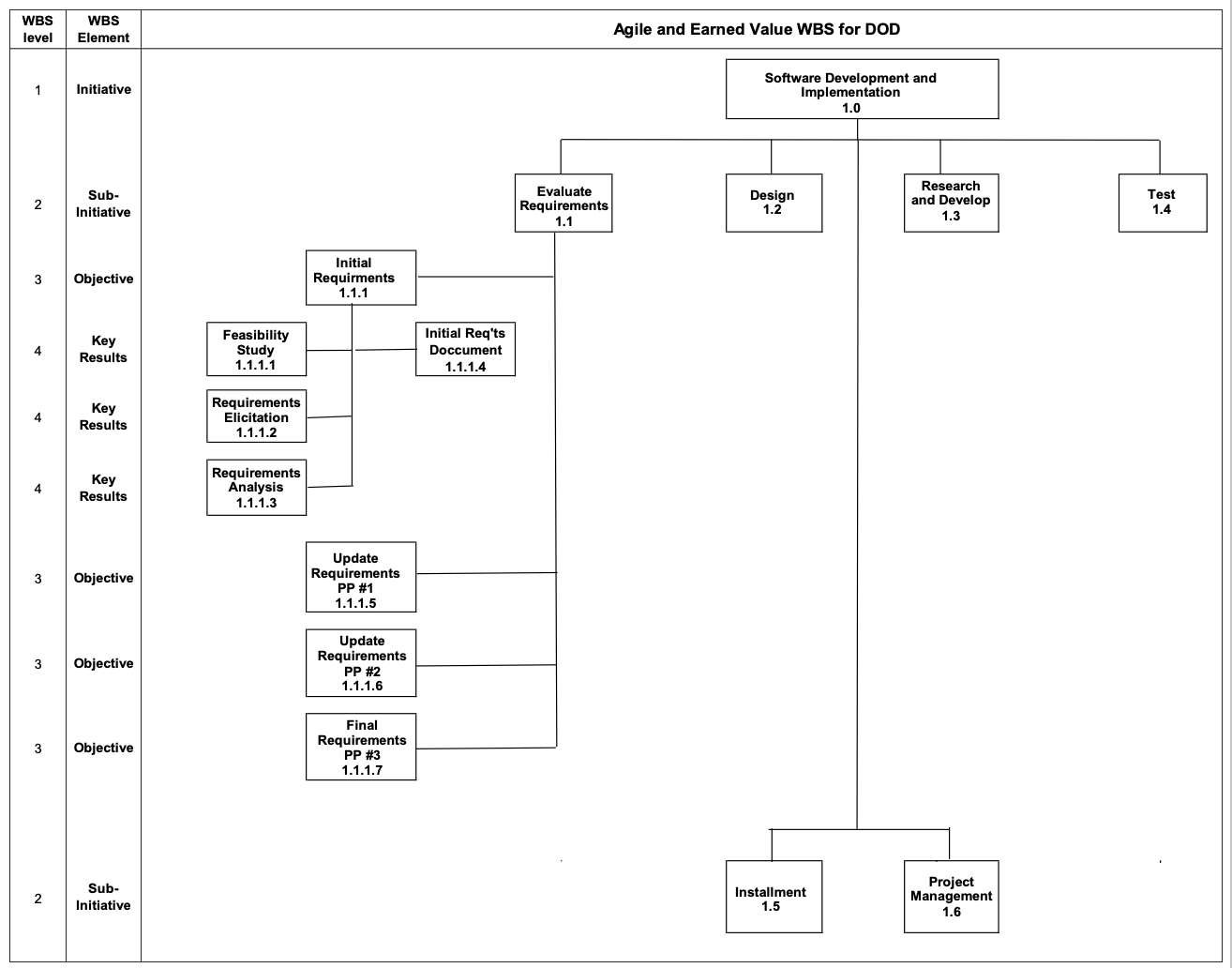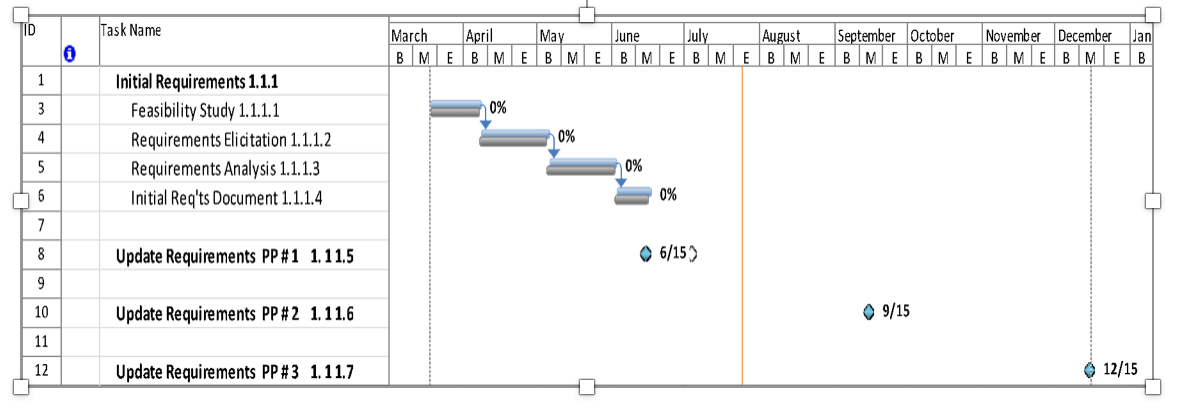 “Department of Defense (D0D) acquisition must improve program while working within budgetary constraints. The DoD community shows an interest in utilizing Agile methodologies, but struggles to reap Agile’s benefits. They encountered challenges including the historically built-up processes that enforce heavy-weight oversight, the outdated, manufacturing focused Work Breakdown Structure (WBS) provided in DoD Handbook: Work Breakdown Structures (WBS) for defense Material Items (MIL-STD-881C), and the inability of traditional waterfall-based process to accommodate iterative development.
“Department of Defense (D0D) acquisition must improve program while working within budgetary constraints. The DoD community shows an interest in utilizing Agile methodologies, but struggles to reap Agile’s benefits. They encountered challenges including the historically built-up processes that enforce heavy-weight oversight, the outdated, manufacturing focused Work Breakdown Structure (WBS) provided in DoD Handbook: Work Breakdown Structures (WBS) for defense Material Items (MIL-STD-881C), and the inability of traditional waterfall-based process to accommodate iterative development.
The author developed the hypothesis that the currently available WBS options in MIL-STD-881C are in conflict with attempts to implement Agile software developed methodologies and Agile Earned Value Management (AgileEVM) on DoD acquisition activities. Modifying MIL-STD-881C to include an iterative -based software development focused WBS would provide the DoD environment with a foundation to begin an overhaul of the current procedures and best practices to better support Agile methodologies and increase the adoption of Agile techniques.” [i]
Roberta Winterowd wrote the article 9 years ago but merging Agile and EVM is still the goal of DoD as evidenced by a guide for Agile and EVM they have published in November 2020. I think Roberta Winterowd is correct. The key to success is a new Work Breakdown Structure (WBS). This paper describes an iterative-based software development focused WBS for consideration as a solution to the problem identified by Roberta Winterowd in his article.
DEFINITIONS
In writing this paper, I have made the assumption that the reader has some knowledge of Agile and Earned Value Management (EVM) in order to keep the length of the paper to a reasonable number of words. In other words, the intent of this paper is not to explain EVM. If the reader wants to increase their knowledge about EVM, there are many online sources to accomplish that.
I have defined a few key terms listed below that are necessary to generate the proposed WBS solution.
Objective and Key Results (OKR)
OKRs originated at INTEL during the early 1980s. Silicon Valley has been using OKRs for years. Google used OKRs to grow their company from 40 employees to more than 60,000 today. Other companies that use OKR, include Apple, Spotify, Twitter, LinkedIn, Walmart, Netflix, and Airbnb.
OKRs are how you track progress around measurable goals. An Objective is what is to be achieved which is usually the product the project is delivering. Key Results (KR) define how you get to the Objective. The goal is to have 4 KRs per Objective. The KRs are specific, have a timeline, budget and yet realistic. Most of all, they are measurable and verifiable. You either meet a KR requirement or you don’t. The Objective has a fixed duration of 3 months. An Objective is essentially the same as a Waterfall Work Package (WP) except the duration is always 3 months. The other important point is, a unique charge number must be assigned to every Objective to collect the actual charges against the Objective. This means anyone working on the Objective must use the charge number. Finance uses the actuals as part of the EVM project performance.
Planning Package (PP)
PPs include efforts that will eventually be identified as separate Objectives. PPs reflect a future segment of work that is not yet broken down into detailed Objectives. PPs have a firm budget, estimated start and complete dates, and task description. The Scrum Masters challenge is to identify as many PPs that he/she feels are needed to provide iterative results (completed Objectives) and flexibility to apply creativity and speed.
Rolling Wave (RW)
Figure 1 below (generated by Humphreys & Associates, one of the best-earned value companies in the U.S.) shows the RW concept. It is based on the Waterfall method that is why it shows WPs. If you interchange WP with Objectives, it works the same way. The figure shows the first 9 months of the project with the WPs detailed out. The remainder of the work is included in the Planning Packages. The Rolling Wave cycle for OKRs is 3 months long not 9 months.
Figure 1 Rolling Wave (RW) Approach
ITERATIVE BASED WBS
Figure 2 shows an example of a software development and implementation iterative-based WBS. Usually on a large complicated project there would be more Sub-Initiatives (e.g., logistics, and quality assurance) included on the WBS but for simplicity’s sake for this paper only the major ones are shown.
The first column to the left is the WBS level. There are 4 levels shown but you can have more levels depending on the size and complexity of the project. Level 2 is the WBS element. It shows the OKR nomenclature. The Initiative is the customer deliverable product which in this case is a software development and implementation system. The Sub-Initiatives are the major subassemblies of the system. The Objectives are the products that have to be completed to achieve the Initiative. The first Objective (Initial Requirements 1.1.1 (WBS identification)) is shown detailed out with the KRs. There are 4 KRs under the Objective which is the desired number. There would be hundreds of Objectives but only 1 is shown to illustrate how it works to keep this paper simple. You can see that there are 3 PPs identified as Objectives. They will be detailed out in accordance with the RW 3-month cycle approach.
Figure 2 Iterative-Based WBS
Objective Schedule
Figure 3 shows the Initial Requirements Objective with the KRs and PPs scheduled. Note the Objective is 3 months long. Also note the PPs are spaced every 3 months to suit the RW 3-month cycle. Each KR is shown linked to other KRs defining the schedule logic. The blue bar line on the schedule is the current schedule while the grey bar is the Performance Measurement Baseline (PMB). The PMB is your proposed plan. It is permanent and can only be changed by the customer. As the project progresses, the current progress (% complete) for each KR are entered into the schedule tool. Any slip of any KR will be seen visibly on the schedule because the blue bar will increase in length and can be compared to the PMB which remains fixed.
During the proposal phase of a project, the Scrum Master can define with the team the first cycle of the Objectives including the KRs. Every 3 months when a new RW cycle is about to begin, the Scrum Master can apply lessons learned from the first cycle, and creativity in detailing out the PP new Objectives. This effort continues until all PPs have been detailed out. This approach provides the iterative and flexibility found in Agile and the OKR structured approach that should reduce the cost and schedule performance of a DoD software development project.
Figure 3 Initial Requirements Objective Schedule
SUMMARY
OKRs and EVM are the linchpins required to merge Agile with Waterfall resulting in an iterative-based DoD software development project. The other vital component to achieve the iterative approach goal is a new WBS that have features required to support the approach.
The WBS presented in this paper is based on standard Project Management and EVM techniques and methodologies that have been around for decades with a proven track record. OKRs have been around since the early 1980s and becoming more popular today.
I suggest the WBS described in this paper should be considered as a potential solution to the DoD software development problem outlined in Roberta Winterowd’s paper. The WBS can also be applied to many industries.
Currently John Ayers is an author, writer, and consultant. He authored a book entitled Project Risk Management. The first is a text book that includes all of the technical information you will need to become a Project Manager (PM). He authored a second book entitled How to Get a Project Management Job: Future of Work. This book shows you how to get a PM job. Between the two, you have the secret sauce to succeed. There are links to both books on Amazon on his website. https://projectriskmanagement.info/. He has presented numerous Webinars on project risk management to PMI including one on June 16 that addresses how to merge Agile with Waterfall to arrive at a Hybrid method. He writes columns on project risk management for CERM (certified enterprise risk management). John also writes blogs for Association for Project Management (APM) in the UK. He has conducted a podcast on project risk management. John has published numerous papers on project risk management and project management on LinkedIn. John also hosts the Project Manager Coach club on clubhouse.com.
John earned a BS in Mechanical Engineering and MS in Engineering Management from Northeastern University. He has extensive experience with commercial and U.S. DOD companies. He is a member of the Project Management Institute (PMI. John has managed numerous large high technical development programs worth in excessive of $100M. He has extensive subcontract management experience domestically and foreign. John has held a number of positions over his career including: Director of Programs; Director of Operations; Program Manager; Project Engineer; Engineering Manager; and Design Engineer. He has experience with: design; manufacturing; test; integration; subcontract management; contracts; project management; risk management; and quality control. John is a certified six sigma specialist, and certified to level 2 Earned Value Management (EVM).
Go to his website above to find links to his books on Amazon and dozens of articles he has written on project and project risk management.
[i] Roberta Winterowd, spring 2013, Agile and EVM for the DoD: a Review of the Challenges and a New Approach to Solve them



